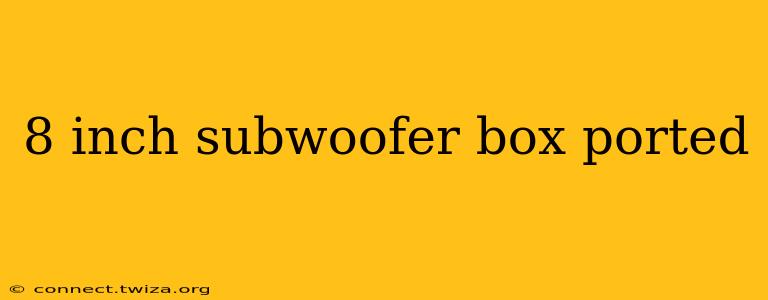8-Inch Subwoofer Box: Ported Enclosure Design and Considerations
Building a ported enclosure for an 8-inch subwoofer is a rewarding project that can significantly enhance your car audio or home theater system. A well-designed ported box optimizes the subwoofer's performance, delivering deeper bass and increased efficiency. However, getting the design right is crucial. A poorly designed box can result in muddy sound, reduced output, or even damage to your subwoofer. This guide will walk you through the key considerations for building a high-performing ported enclosure for your 8-inch subwoofer.
Understanding Ported Subwoofer Enclosures
A ported enclosure, also known as a bass reflex enclosure, uses a port (a tube or duct) to extend the low-frequency response of the subwoofer. The port works in conjunction with the subwoofer cone, allowing air to move in and out of the enclosure, reinforcing certain frequencies and creating a more powerful bass response. This contrasts with sealed enclosures, which generally offer tighter, more controlled bass but with less overall output.
Choosing the Right Port Design
Several factors influence port design:
- Port Length: This is the most critical factor determining the tuning frequency of the enclosure. The tuning frequency (ft) is the frequency at which the port and subwoofer work together most effectively. Calculating the correct port length is crucial and often requires specialized software or online calculators (many are available free online). Incorrect port length can significantly impact the overall sound.
- Port Diameter: The diameter of the port affects airflow. Larger diameter ports generally allow for more airflow, but they may also introduce more turbulence, impacting sound quality. A balance needs to be struck, and software or calculators will help you find the optimal size.
- Port Material: Common materials include PVC pipe, wood, or even ABS plastic. The material choice should consider durability, ease of construction, and the potential for resonance.
Important Considerations When Designing Your 8-Inch Ported Subwoofer Box
What size port do I need for an 8-inch subwoofer?
The ideal port size isn't a fixed number; it depends heavily on the specific subwoofer's parameters (Thiele-Small parameters or T/S parameters), the desired tuning frequency, and the internal volume of the box. There's no single "correct" answer. Using a subwoofer modeling program or an online calculator that takes the T/S parameters as input is essential for accurate port design. The calculator will provide the necessary port length and diameter based on your subwoofer's specifications and the desired tuning frequency.
What is the best port design for an 8-inch subwoofer?
Several port designs exist, each with advantages and disadvantages:
- Round Ports: These are the most common and easiest to construct.
- Slot Ports: These offer a larger surface area for airflow, potentially reducing port noise at high output levels, but they are more challenging to build precisely.
- Flare Ports: These ports gradually widen towards their ends, minimizing turbulence and improving airflow. They are often more complex to construct.
The best port design depends on factors like the available space, your woodworking skills, and the desired aesthetic.
What is the best material for an 8-inch subwoofer port?
The best material is one that is rigid, non-resonant, and durable. Common options include:
- PVC pipe: readily available and inexpensive
- Wood: offers excellent rigidity and can be shaped to match the enclosure.
- ABS plastic: durable and can be easily shaped, though it may be more costly.
Avoid materials that are easily deformed or prone to resonance as this could negatively affect the sound quality.
How do I calculate the correct port length for an 8-inch subwoofer?
Calculating the correct port length is crucial. Use a subwoofer modeling program or an online calculator that takes the following inputs:
- Subwoofer T/S parameters: These parameters describe the subwoofer's electrical and mechanical characteristics, usually found in the subwoofer's specifications.
- Desired tuning frequency (ft): This is the frequency at which the port and subwoofer will work most effectively. This will affect the bass response character – a lower ft generally results in more extended low-bass, while a higher ft provides tighter, punchier bass.
- Internal volume (Vb): The volume of air inside the subwoofer enclosure.
Building Your Ported Enclosure:
Once you have your design, building the enclosure involves precise cuts, assembly, bracing, and finishing. Ensure you use appropriate tools and techniques for clean construction to prevent unwanted resonances and vibrations.
Conclusion:
Building a ported enclosure for an 8-inch subwoofer requires careful planning and precise execution. Utilizing online resources and subwoofer modeling software will guarantee you achieve optimal performance from your subwoofer system. Remember that accuracy is paramount in this process, so take your time and pay close attention to detail. The reward of a well-tuned system is well worth the effort.
